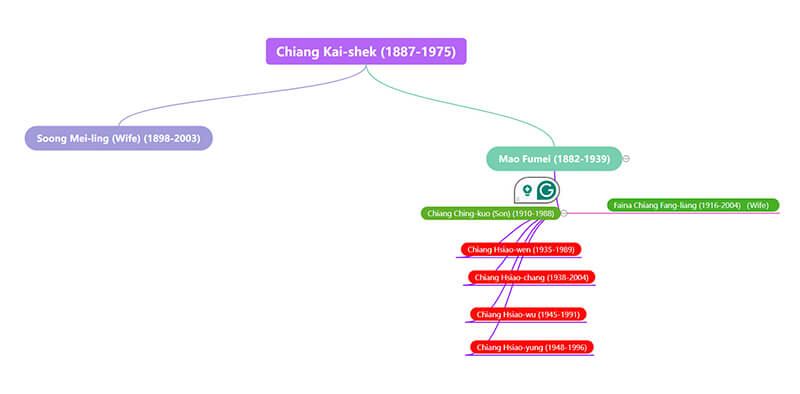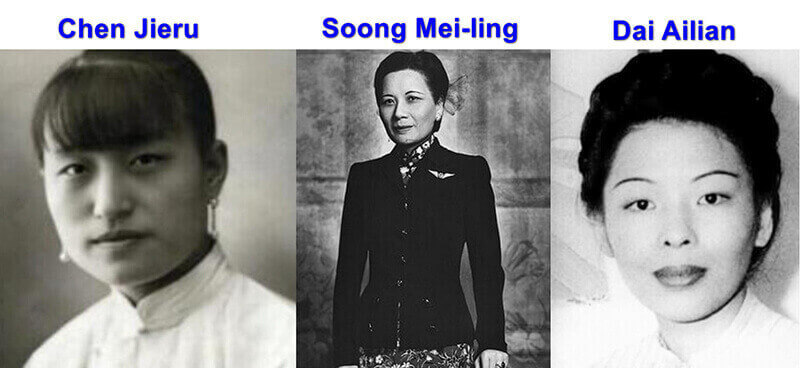The Chiang Kai Shek Family Members (2025 Updated)
Chiang Kai Shek is one of the most significant figures in modern Chinese history. As the leader of the Republic of China, his impact stretched far beyond politics. His life was intertwined with complex family dynamics, deep historical influences, and moments of both triumph and tragedy. Understanding the Chiang Kai Shek family tree offers valuable insights not only into his own life but also into the political, social, and historical backdrop of China in the 20th century.
In this article, we will learn about Chiang Kai Shek’s life, his family background, how to create a family tree for the Chiangs, and the intricate web of relationships within his family. Let’s take a closer look.

- Part 1. Who Is Chiang Kai Shek?
- Part 2. The Chiang Kai Shek Family Tree: A Historical Overview
- Part 3. How to Create a Chiang Kai Shek Family Tree Using MindOnMap
- Part 4. How Many Wives Did Chiang Kai Shek Have?
- Part 5. FAQs About the Chiang Kai Shek Family
Part 1. Who Is Chiang Kai Shek?
Chiang Kai Shek was born on October 31, 1887, in Xikou, Zhejiang Province, China. His full name, Chiang Chieh-shih (蔣介石), became synonymous with political power and military leadership. Chiang is most famously known for his role as the leader of the Republic of China (ROC) from the late 1920s until he died in 1975. His life was marked by pivotal moments, such as his role in the Northern Expedition, the Chinese Civil War, his confrontation with the Japanese invaders during the Second Sino-Japanese War, and his eventual retreat to Taiwan.
Chiang was a key military and political figure in 20th-century China, leading the Nationalist Party (Kuomintang, or KMT). He sought to unify China and modernize it while also resisting Communist influence. Chiang’s leadership saw both prosperity and struggle. His attempts to fight off the Japanese during World War II earned him recognition. Still, his long-term conflict with the Communist Party, led by Mao Zedong, resulted in the Nationalists’ eventual retreat to Taiwan after the Chinese Civil War. This pivotal moment marked the beginning of the ROC’s presence on the island.
Beyond his political life, Chiang was known for his deep devotion to his family, which influenced many aspects of his personal and political decisions.

Part 2. The Chiang Kai Shek Family Tree: A Historical Overview
Chiang’s family tree is an interesting reflection of the broader historical forces at play in China during his time. His family was one of considerable status, though their roots were more humble compared to some of the aristocracy in China. His father was a merchant, and Chiang’s early life involved a strong influence of Confucian values.
Key Figures in the Chiang Family Tree:
• Chiang Kai Shek (1887-1975) – The leader of the Nationalist government of the Republic of China.
• Soong Mei-ling (1898-2003) – Chiang’s most famous wife and a pivotal political figure in her own right.
• Chiang Ching-kuo (1910-1988) – Chiang Kai Shek’s son, who became the President of the Republic of China (Taiwan) after his father.
• Soong Ching-ling (1893-1981) – Chiang's sister-in-law and the wife of Sun Yat-sen, the founding father of the Republic of China. She became a prominent figure in the Communist Party of China.
In terms of political legacy, the Chiang family tree stands as one of the most influential in 20th-century China. The family played significant roles in both the Nationalist and Communist movements, with family members deeply involved in key moments in the history of modern China.
To learn the relationship in detail, you can check the family tree in the next part.
Part 3. How to Create a Chiang Kai Shek Family Tree Using MindOnMap
For those who are keen to delve deeper into the Chiang Kai Shek family history, creating a family tree is a fantastic way to visualize and understand the connections. One effective tool for this is MindOnMap, a simple and intuitive mind-mapping software. MindOnMap can help you organize historical figures, their relationships, and key events in the Chiang family history.
MindOnMap is an online and desktop tool that helps you create visually appealing family trees, timelines, and mind maps. It’s incredibly easy to use and offers a range of templates to customize the look and feel of your project. Whether you’re a history enthusiast or just looking to explore the Chiang family’s rich legacy, MindOnMap is a great way to get started.
• Drag-and-drop interface – Cloud integration (1887-1975) – Save your family tree online and access it from anywhere.
• Export options – Once your family tree is complete, you can export it in various formats,Now, let’s follow the steps to create a Chiang Kai Shek family tree with MindOnMap.
First, visit the official MindOnMap website and sign up for an account or download the application on your Windows or Mac computer. Here, we will take its web version as an example to make a Chiang Kai Shek family tree.
Click the New button from the left sidebar, and select the "Tree Map" template to get started.
Here, you can start by adding Chiang Kai Shek at the root of the tree and begin adding his family members, including his parents, spouses, children, and other relatives. Use the "Add Node" feature to add details about each family member.

Here, you can use lines or arrows to link individuals based on their relationship (spouse, parent-child, sibling).
Moreover, if you have images of key family members, you can add them to your map for a more personalized touch.
Moreover, you can easily add and organize Chiang Kai Shek family members, historical events, and relevant facts in this family tree timeline.

Once you’re satisfied with your family tree, click the "Share" button to save your creation by sharing via a link or downloading it as a PDF or image file locally.
Creating a Chiang Kai Shek family tree with MindOnMap will give you a clear and organized view of the family’s significant influence on Chinese history.
Part 4. How Many Wives Did Chiang Kai Shek Have?
Chiang Kai Shek’s family life was both complex and traditional for his time. While many people know about his marriage to Soong Mei-ling, there is more to the story. Chiang had three wives in total, each of whom played different roles in his life and legacy.

1. Chen Jieru (First Wife)
Chiang’s first marriage was to Chen Jieru, a woman of humble origins. She was from a family with modest means, and their marriage occurred when Chiang was still a young man studying in Japan. However, the marriage was short-lived, and they eventually separated. The details surrounding their separation remain unclear, but it is believed that Chiang's career and political ambitions led to the dissolution of their relationship.
2. Soong Mei-ling (Second Wife)
Chiang’s second and most famous wife was Soong Mei-ling, often known as Madame Chiang Kai Shek. She was from a prominent family in China, the Soong family, whose influence extended throughout Chinese politics and business. Soong Mei-ling was highly educated, fluent in English, and played a significant role in supporting Chiang’s political career. As the First Lady of the Republic of China, she was a key spokesperson for the Nationalist government, both in China and abroad. Her diplomatic efforts were crucial in securing American support during the Second Sino-Japanese War.
3. Dai Ailian (Third Wife)
Chiang's third wife, Dai Ailian, was less well-known and had a more private relationship with him. Unlike his other wives, Dai was not involved in politics and did not take on a public role. Her relationship with Chiang was one of mutual respect, and she lived with him during his later years in Taiwan.
Part 5. FAQs About the Chiang Kai Shek Family
What was Chiang Kai Shek’s relationship with the Soong family?
Chiang’s relationship with the Soong family was both political and personal. He married Soong Mei-ling, the sister of Soong Ching-ling, who was married to Sun Yat-sen, the founder of the Republic of China. The Soong family was highly influential in Chinese politics, and their connections helped Chiang gain political support throughout his career.
What was Chiang’s relationship like with his son, Chiang Ching-kuo?
Chiang Ching-kuo, Chiang Kai Shek’s son, played a key role in the administration of Taiwan. Although Chiang Ching-kuo initially had a strained relationship with his father, especially regarding political differences, he later became an influential figure in Taiwan’s government and helped modernize the island’s economy.
Why did Chiang Kai Shek retreat to Taiwan?
Chiang Kai Shek retreated to Taiwan in 1949 after the Communist Party of China, led by Mao Zedong, took control of mainland China. Chiang’s government continued to claim legitimacy as the government of all of China. Still, Taiwan became the stronghold of the Republic of China, and Chiang’s leadership persisted there until he died in 1975.
Conclusion
Chiang Kai Shek’s life, family, and legacy are deeply intertwined with the modern history of China and Taiwan. The Chiang Kai Shek family tree is a fascinating journey through political intrigue, family dynamics, and historical moments that shaped the world. By exploring his family life, we not only learn more about Chiang as a man but also about the forces that influenced his decisions and the history he helped write.
If you're interested in learning more, creating a family tree of the Chiangs using tools like MindOnMap is an excellent way to visualize the family’s history and its lasting impact on China and Taiwan. The Chiangs’ story is one of power, ambition, and legacy-a truly fascinating chapter in the story of China’s 20th century.










